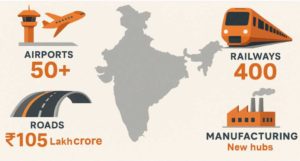Introduction

![]() India’s safety equipment sector is poised for exponential growth. With industrial expansion, large-scale infrastructure projects, and global manufacturers setting up bases in India, the market is projected to grow 30–40% annually. Compliance with BIS and international standards is the key driver – replacing substandard gear could nearly double market sales.
India’s safety equipment sector is poised for exponential growth. With industrial expansion, large-scale infrastructure projects, and global manufacturers setting up bases in India, the market is projected to grow 30–40% annually. Compliance with BIS and international standards is the key driver – replacing substandard gear could nearly double market sales.
The Growth Drivers:
Airports: India targets 50+ new airports by 2030, reaching close to 200 airports in total.
Railways: Pradhan Mantri Gati Shakti will deliver 400 Vande Bharat trains and 500+ new/modernized terminals.
Roads: About Rs. 105 lakh crore will be needed to extend India’s road network by 2.4 million km to reach 90% rural access by 2030.
Manufacturing: New plants in semiconductors, automobiles, tractors, and ammunition sectors are creating thousands of jobs.

INDIA’S INFRASTRUCTURE EXPANSION BY 2030
Safety Industry Market Outlook
If India’s 500 million+ workers adopt safety shoes, helmets, and harnesses even at 50% of international standards, the safety equipment industry could double in size.
(Safety Market Growth Projection 2024–2030)
 R&D: The Missing Link
R&D: The Missing Link
While infrastructure is growing, one challenge remains: innovation in safety gear. Too often, counterfeit BIS licenses and imported substandard gear dominate the market. For India to become a global hub of safety products, we need:
Greater R&D investment by domestic players.
- Collaboration between industry + academia for innovation.
- Development of smart safety gear (IoT-enabled helmets, ESD/Dielectric footwear, etc.).
- Alignment with PM Modi’s “Make in India” vision by reducing imports and scaling local production.
Conclusion
India’s safety industry stands at a historic moment. With airports, railways, roads, and factories multiplying, the demand for quality safety gear will skyrocket. The winners will be those companies that:
- Commit to R&D
- Deliver BIS & global standard products
- Support India’s push toward self-reliance
“Safety is not a cost—it’s an investment in people, productivity, and India’s industrial future.”























































